As an Amazon Associate KitchenwareSets.com earns from qualifying purchases.
Gorgeous Green And Brown Kitchen Ideas That Wont Look Dark
Struggling to choose a kitchen color that feels both timeless and full of personality? You’re not alone in wanting a space that’s warm, inviting, and uniquely you.
A green and brown kitchen color scheme brings the calming, earthy feel of nature right into your home. The biggest fear is creating a space that feels too dark or heavy. This is a common and valid concern.
To keep a green and brown kitchen bright, the key is to balance deep colors with light neutrals, maximize both natural and layered artificial light, and use reflective surfaces. This guide will show you exactly how to achieve a gorgeous, airy look. You’ll discover nine stunning ideas and the designer principles that make them work.
Why Does a Green and Brown Kitchen Feel So Right (And How Do We Keep It Bright)?
A green and brown kitchen creates a warm, natural feel by mimicking colors found in nature. To keep it from looking dark, the key is to balance deep colors with light neutrals, maximize natural and artificial light, and use reflective surfaces like satin paint finishes and metallic hardware. This color combination taps directly into the principles of biophilic design, which connects our indoor spaces to the natural world to create a calming, serene environment.
The psychology is simple: green is associated with tranquility and health, while brown provides a sense of grounding and stability. The combination feels inherently comforting. The primary fear, however, is that this earthy palette will result in a dark, cavernous room. The secret to success lies in balance. By strategically incorporating a third light neutral color—like creamy white or soft beige—and layering your lighting, you can create a space that is both cozy and bright. This post is filled with actionable strategies and visual proof to show you exactly how.
9 Gorgeous Green And Brown Kitchen Ideas That Feel Bright & Airy
Ready for some real-world inspiration? We’ve curated a collection of nine distinct and achievable green and brown kitchen ideas. Each example was chosen specifically to demonstrate how to balance this beautiful color palette for a bright, welcoming result. These designs are based on successful projects and interior designer best practices, proving that you don’t have to sacrifice light to embrace rich, natural color.
1. The Light & Airy: Soft Sage Green with Natural Oak Accents
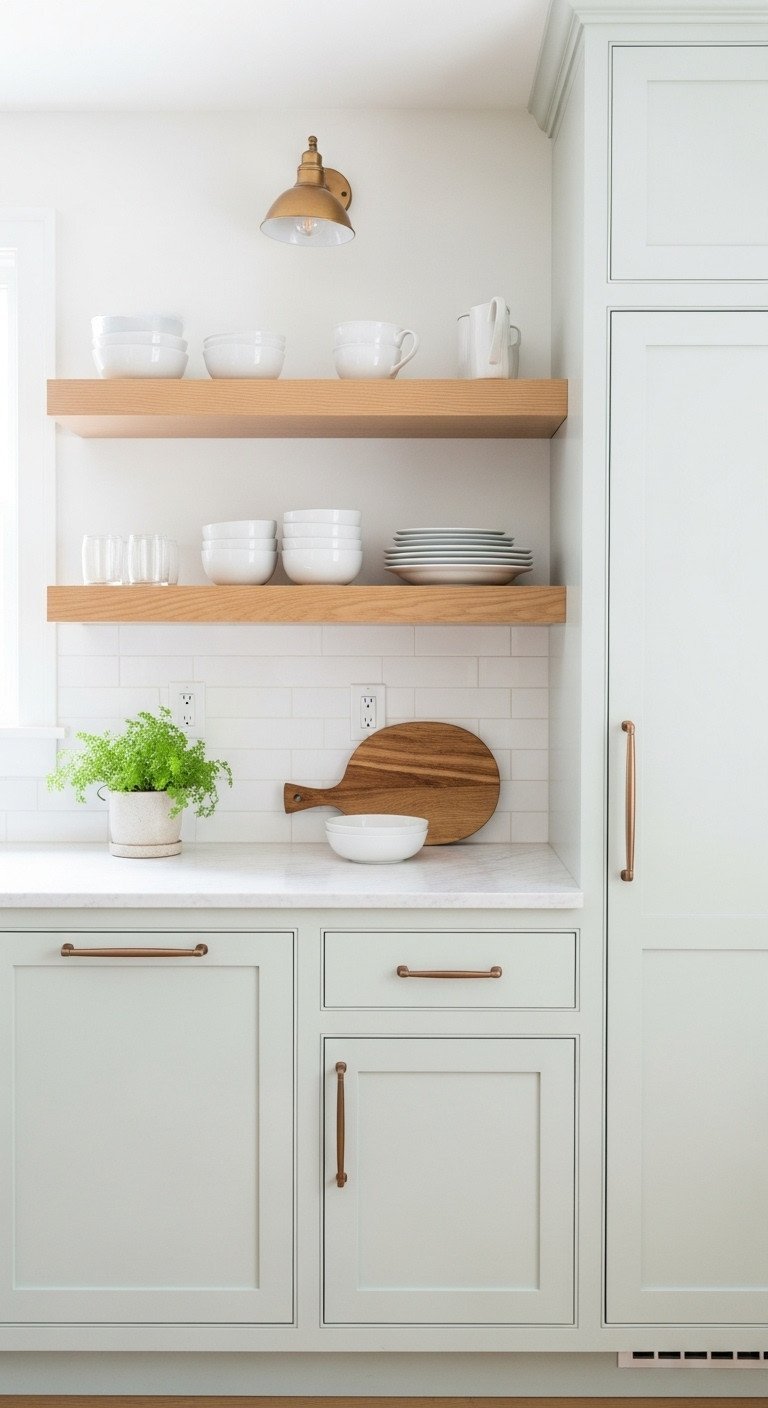
Pin this serene kitchen idea for a timeless look!
This combination is perfect for anyone who loves the green and brown concept but wants to ensure the final look is subtle, bright, and calming. The soft sage green has a high Light Reflectance Value (LRV), meaning it bounces light around the room, while the natural oak adds organic warmth without feeling heavy.
Materials Needed:
- High-quality cabinet paint in a soft sage green with a satin finish (e.g., Benjamin Moore October Mist)
- Solid natural white oak boards for floating shelves
- Heavy-duty concealed floating shelf brackets
- Modern cabinet pulls and knobs in a warm champagne bronze finish
- Simple white or off-white ceramic tile for the backsplash (3×6 subway or 4×4 zellige)
- A durable, light-colored countertop material like white quartz or marble
Step-by-Step Directions:
- Prep & Paint: Properly prep and paint the kitchen cabinets in your chosen sage green. A satin finish is crucial for reflecting light and ensuring easy cleaning.
- Install Shelving: Instead of traditional upper cabinets, install 2-3 thick natural oak floating shelves to create an open, airy feeling.
- Add Warmth with Hardware: Install the champagne bronze hardware. This warm metal acts as jewelry, beautifully bridging the gap between the cool green and the warm wood.
- Keep it Light: Pair with a bright white countertop and backsplash to maximize light reflection and provide a crisp contrast.
- Style Simply: Decorate shelves with white dishes, clear glassware, and touches of greenery to maintain the uncluttered, fresh aesthetic.
Pro-Tip: Test your sage green paint sample next to your oak wood sample. Some sages have cool, blue undertones while others are warmer. Ensure they have a harmonious relationship before you commit.
2. The Moody & Sophisticated: Forest Green with a Rich Walnut Island
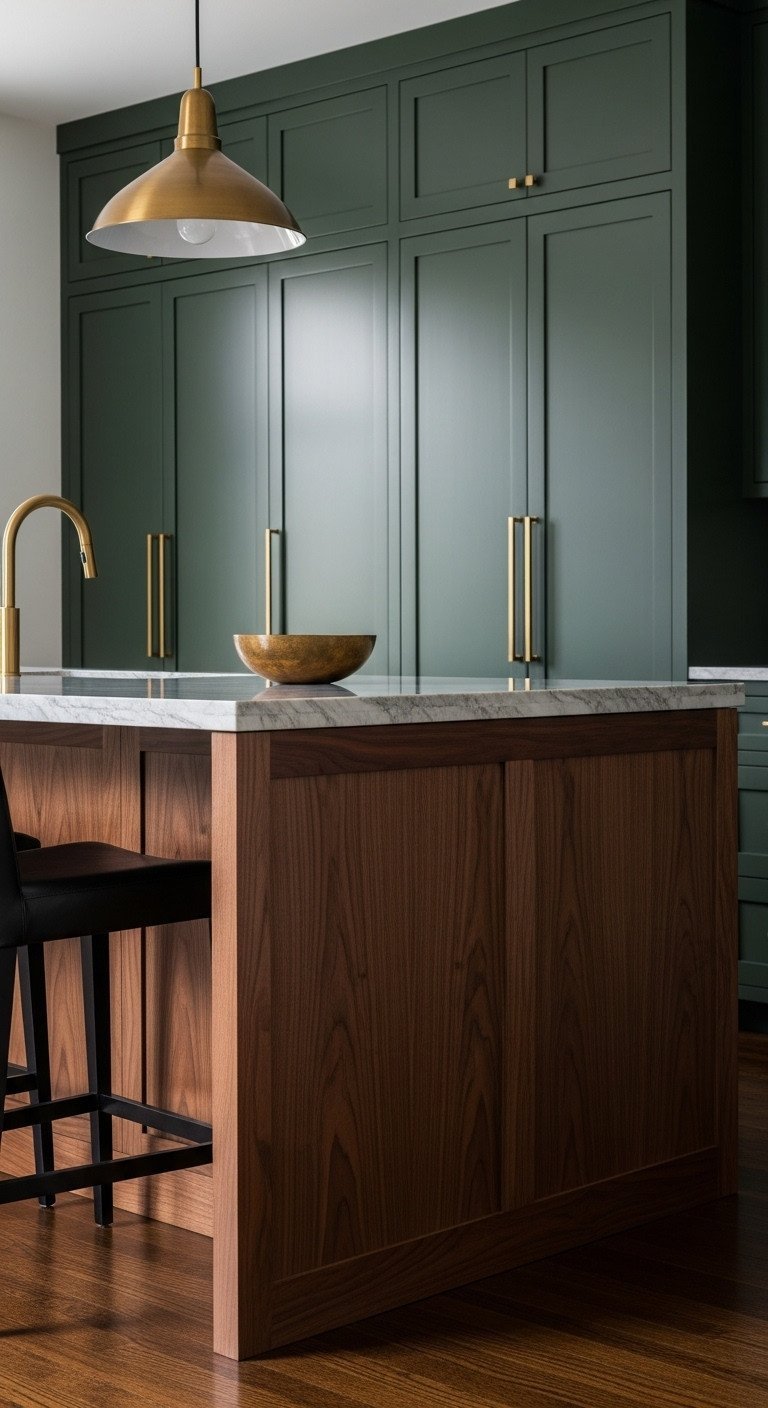
Save this dramatic kitchen inspiration for a high-end look!
For those who want to embrace a bolder, more luxurious aesthetic, this combination is a showstopper. The deep forest green cabinets create a cozy, enveloping feel, while the rich walnut kitchen island serves as a stunning, warm focal point. This look proves that “dark” can feel sophisticated and inviting, not gloomy.
Materials Needed:
- Deep forest green paint with a matte or low-lustre finish (e.g., Farrow & Ball Studio Green)
- High-quality walnut veneer or solid walnut for the island
- A statement pendant light fixture in a warm brass finish
- Minimalist matte black cabinet pulls or a handleless push-to-open system
- Light-colored quartz countertop with subtle veining for the perimeter cabinets
Step-by-Step Directions:
- Go Bold on Cabinets: Paint the perimeter cabinets in the deep forest green. A matte finish will absorb light and create a velvety, rich look.
- Create a Focal Point: Make the island the star using a warm, rich walnut. A waterfall edge, where the countertop material flows down the side, adds a sleek, modern touch.
- Inject Light & Glamour: Hang one or two large, sculptural brass pendant lights directly over the island. This is a key element for both task lighting and breaking up the darkness.
- Add Contrast: Use a light-colored countertop on the green perimeter cabinets. This prevents a “black hole” effect and helps bounce light around the room.
- Use Understated Hardware: Choose sleek matte black hardware or go handleless to let the colors and materials be the focus.
Lesson Learned: This look requires excellent lighting. Ensure you have ample ambient lighting (recessed cans) and under-cabinet task lighting in addition to the statement pendants.
3. The Earthy & Warm: Olive Green with Butcher Block Countertops
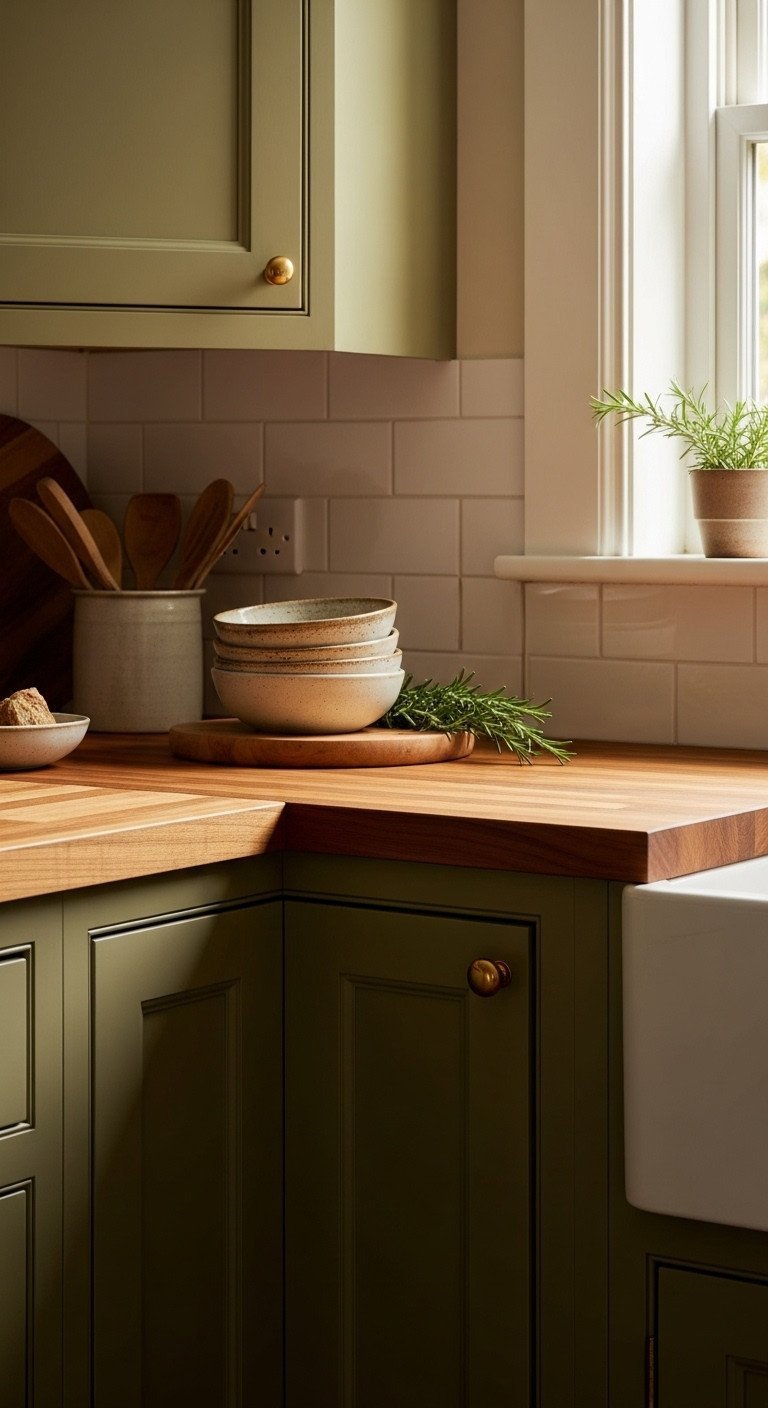
Pin this cozy and organic kitchen idea!
This pairing is the epitome of an earthy, natural kitchen. The warm undertones in a complex olive green harmonize perfectly with the golden hues of butcher block countertops. It’s a look that feels organic, lived-in, and deeply connected to nature, perfect for a modern farmhouse or country-inspired home.
Materials Needed:
- A warm, complex olive green paint (e.g., Sherwin-Williams Ripe Olive) in an eggshell or satin finish
- Thick butcher block countertops (maple, oak, or walnut)
- Food-safe oil or sealer for wood countertops
- Creamy, off-white zellige tiles for a textured, handmade-look backsplash
- A classic farmhouse sink
- Vintage-inspired unlacquered brass hardware and faucet
Step-by-Step Directions:
- Choose a Warm Green: Select an olive green with distinct warm, yellow, or brown undertones. This is key to creating a harmonious look with the warm wood.
- Install Butcher Block: Fit the butcher block countertops. Their natural warmth is the perfect brown counterpart to the earthy green. Seal them properly for durability.
- Add Texture: Install a backsplash of creamy zellige tiles. The slight imperfections and glossy surface will reflect light and add a layer of rustic texture.
- Incorporate Classic Elements: A white fireclay farmhouse sink provides a bright focal point and breaks up the color and wood tones.
- Use Living Finishes: Opt for unlacquered brass hardware. It will develop a natural patina over time, enhancing the kitchen’s warm, lived-in character.
Pro-Tip: Butcher block requires maintenance. Be prepared to oil it every few months to keep it looking its best. For a lower-maintenance option, use butcher block on a low-traffic area like an island and a more durable material like quartz elsewhere.
4. The Balanced Act: Two-Tone with Green Lowers & Wood Uppers
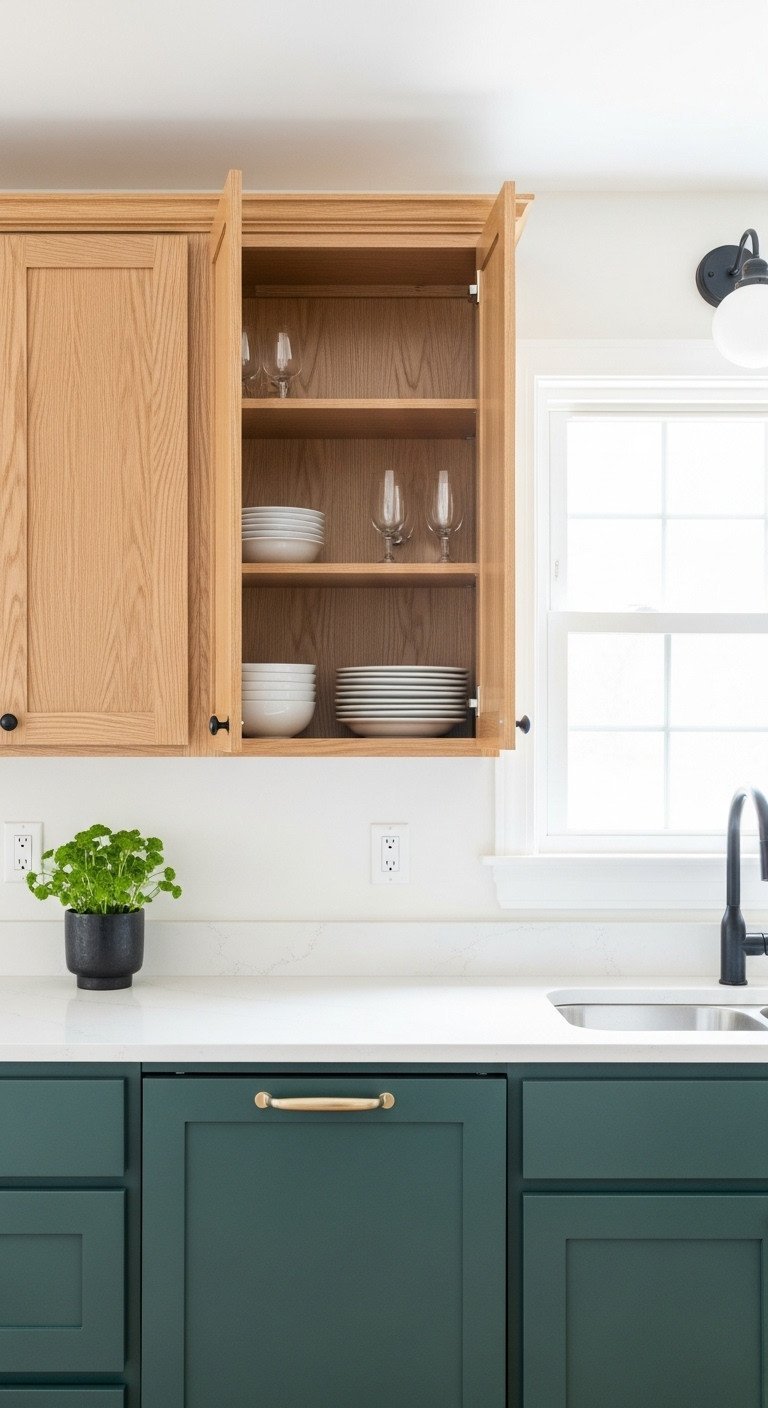
Love this two-tone look? Pin it for your kitchen reno!
The two-tone kitchen is a brilliant design principle for using dark colors without making a room feel small. By grounding the space with dark green lower cabinets and using light wood for the uppers, you draw the eye upward, creating an illusion of height and openness.
Materials Needed:
- Dark green cabinet paint in a satin finish
- Light wood upper cabinets or open shelving (e.g., white oak or maple)
- A bright white or very light gray quartz countertop with minimal pattern
- Simple, modern hardware in matte black or brushed nickel
- Under-cabinet LED strip lighting
Step-by-Step Directions:
- Ground the Space: Paint only the lower cabinets with the dark green color. This anchors the room visually without overwhelming the vertical space.
- Lift the Eye Upward: Use natural light wood for all upper cabinets or, for an even airier feel, opt for open shelving. This draws the eye up and makes the ceiling feel higher.
- Create a Clean Break: Install a crisp white quartz countertop. This acts as a reflective, horizontal band of light that cleanly separates the dark lowers from the light uppers.
- Light the Work Surface: Install under-cabinet LED lighting beneath the wood uppers. This is critical for task lighting and it also highlights the countertop, adding to the bright feel.
- Keep Hardware Simple: Use simple, modern hardware that doesn’t compete for attention. Matte black will create a graphic contrast.
Lesson Learned: The success of this look hinges on the countertop. A dark countertop will negate the brightening effect of the two-tone design. Stick to white or very light gray.
5. The Urban Industrial: Dark Green with Concrete-Look Countertops

Save this cool, industrial kitchen vibe to your design board!
This style proves that green and brown can be edgy and modern. The pairing of sleek, dark green cabinets with the raw texture of a light gray concrete-look countertop creates a sophisticated, urban aesthetic. The “brown” element is introduced through warm, textural accents like an exposed brick backsplash or reclaimed wood.
Materials Needed:
- Deep green paint with a matte finish
- Flat-panel or slab-style cabinet doors for a minimalist look
- A durable countertop in a light gray concrete finish (quartz is a great low-maintenance option)
- Thin brick veneer for an exposed brick backsplash effect
- A high-arc, gooseneck faucet in a matte black finish
- Minimalist edge pulls or tab pulls for hardware
Step-by-Step Directions:
- Streamline the Cabinets: Use sleek, flat-panel cabinets painted in a dark, moody green. The lack of detail keeps the look modern and clean.
- Choose a Cool Brown: In this style, the “brown” comes from the warm, textural exposed brick backsplash. This provides the necessary warmth to balance the cool tones of the green and concrete.
- Opt for Concrete-Look Counters: Select a light gray concrete-look countertop. This industrial material provides a bright, neutral surface that contrasts sharply with the dark green cabinets.
- Incorporate Black Accents: A matte black faucet and minimalist hardware reinforce the industrial aesthetic and add a strong graphic element.
- Add Natural Wood: Bring in warmth and a connection to the “brown” theme with accessories like thick reclaimed wood cutting boards or a small wooden stool.
Pro-Tip: Real concrete countertops are porous and require significant sealing and maintenance. For the same look with much better durability, choose a high-quality quartz that mimics the look of concrete.
6. The Rustic Revival: Distressed Green with Reclaimed Wood
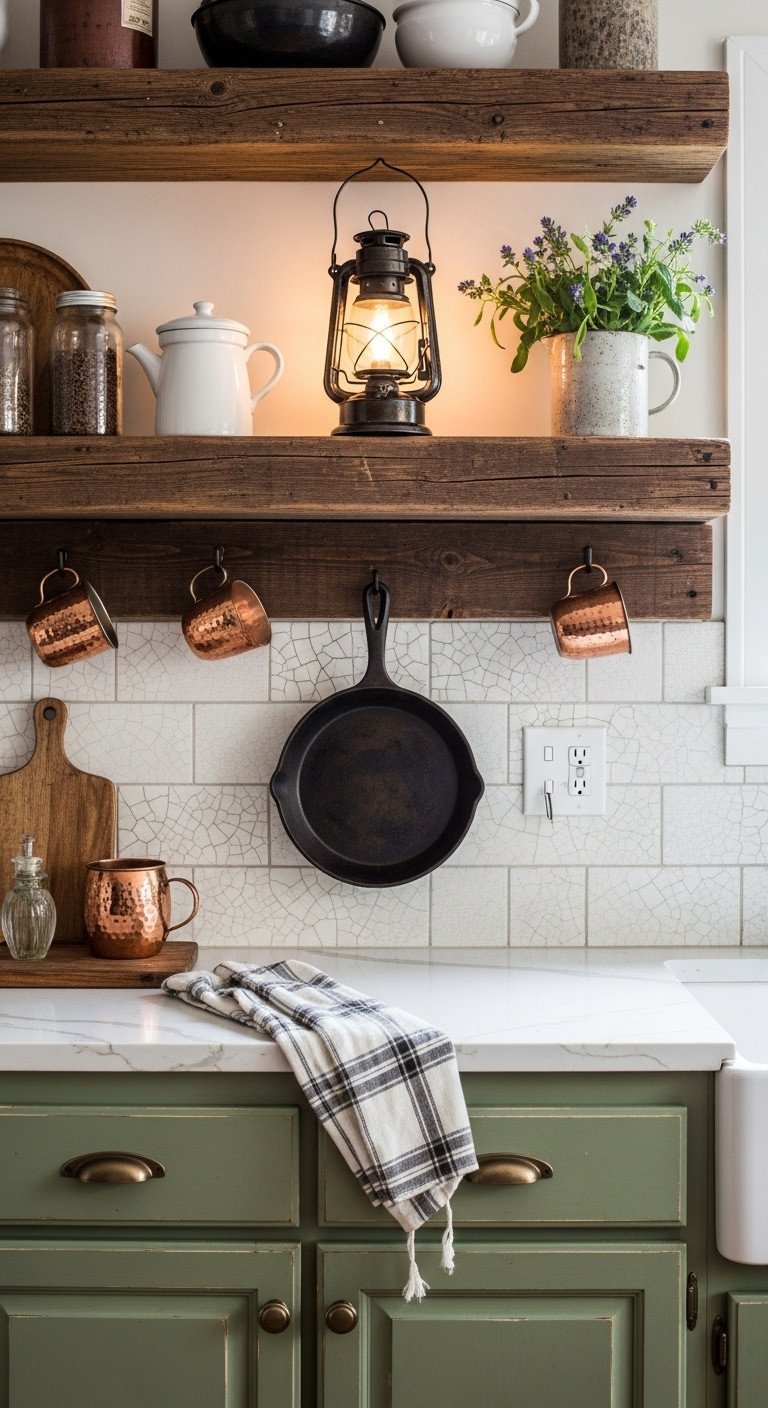
Pin this cozy, rustic kitchen idea for ultimate farmhouse charm!
To create a kitchen with authentic rustic character, texture is everything. Distressed green cabinets have a soft, aged look that pairs perfectly with the rugged, imperfect nature of reclaimed barn wood. This style is all about creating a sense of history and warmth.
Materials Needed:
- Chalk-style paint in a muted moss or faded olive green
- Fine-grit sandpaper and dark wax for distressing
- Authentic reclaimed barn wood for open shelves or an island top
- A dark, matte countertop material like soapstone or honed black granite
- Hardware with a handmade feel, such as hammered copper or oil-rubbed bronze pulls
- A simple, light-colored backsplash to keep it from getting too dark
Step-by-Step Directions:
- Create a Distressed Finish: Paint your cabinets with chalk-style paint. Once dry, lightly sand the edges and high-traffic areas to reveal the wood underneath. Seal with a clear and then a dark wax to create an aged look.
- Embrace Imperfection: Use heavily textured, reclaimed wood for open shelving, a range hood cover, or ceiling beams. The knots, nail holes, and grain variations are the star of this look.
- Choose a Hardworking Countertop: A dark, honed countertop like soapstone complements the rustic aesthetic. It will patina over time, adding to the character.
- Balance with Light: Because the cabinets and wood are medium-to-dark, it’s vital to use a light-colored backsplash (like a simple cream tile) and have good lighting to maintain brightness.
- Add Warm Metals: Use hardware in a warm, textured finish like hammered copper or oil-rubbed bronze to complete the rustic, handcrafted feel.
Lesson Learned: Distressing is an art. Practice on a spare cabinet door first. The key is to make it look naturally worn, focusing on areas that would realistically see more use.
7. The Bright Pop: Wood Cabinets with a Vibrant Green Backsplash
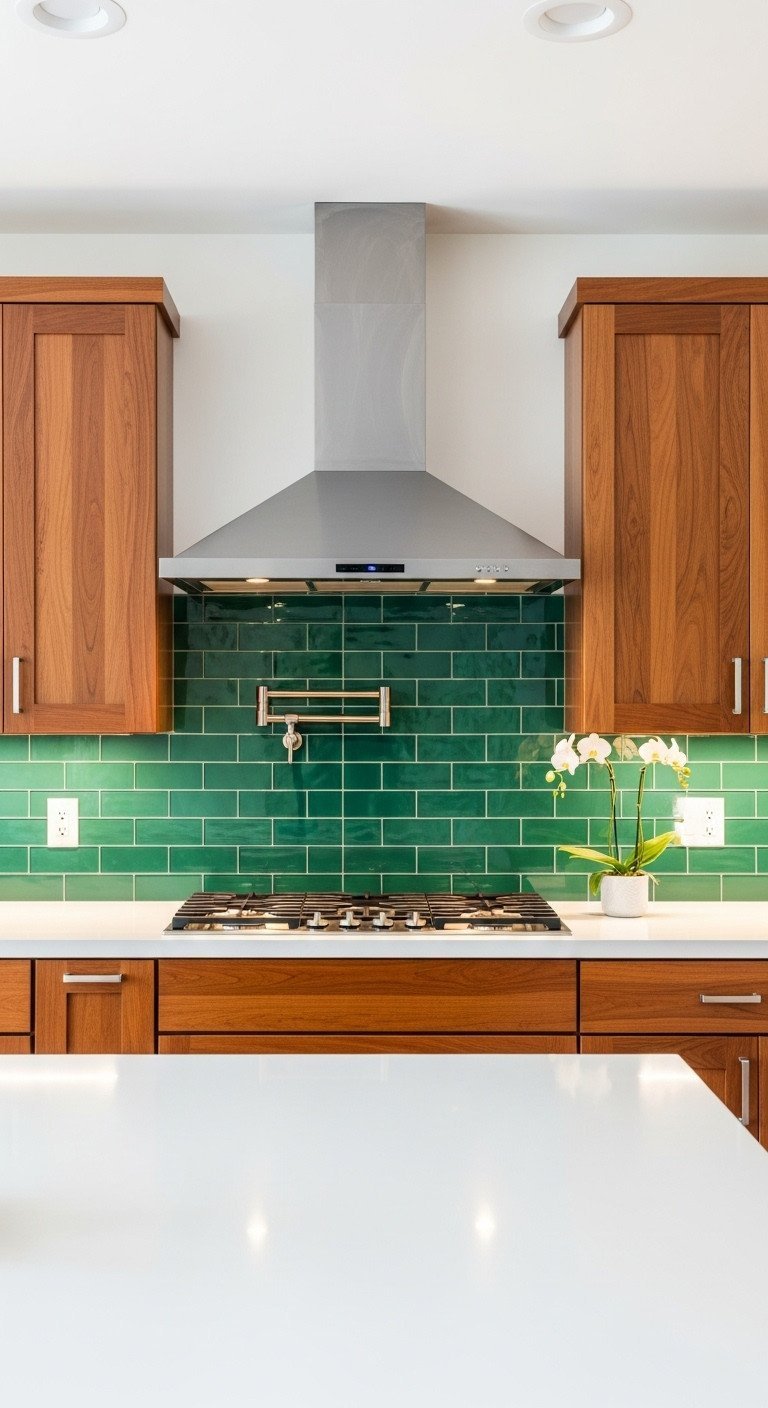
A pop of green! Save this idea to brighten up wood cabinets.
If you already have brown wood cabinets and want a high-impact, low-commitment way to add green, the backsplash is your answer. A vibrant green tile in a glossy finish can completely transform a kitchen, reflecting light and adding a modern, energetic feel without the massive undertaking of painting cabinets.
Materials Needed:
- Glossy ceramic or glass tiles in a vibrant green (emerald, kelly, or lime)
- High-quality tile adhesive and grout (a light gray or white grout is recommended)
- A solid, bright white countertop to provide a neutral base
- Modern stainless steel or brushed nickel hardware
- Under-cabinet lighting to make the backsplash shine
Step-by-Step Directions:
- Keep Cabinets Natural: Let the beautiful grain of your existing brown wood cabinets be the star. Clean and polish them to bring out their natural warmth.
- Make a Statement: Install the vibrant green tile for the backsplash. A glossy finish is key, as it will reflect a huge amount of light around the room, instantly making it feel brighter.
- Neutralize the Countertop: This look works best with a simple, solid white countertop. This provides a visual break and prevents the wood and green from competing.
- Light It Up: Install under-cabinet lighting. This is non-negotiable for this idea, as it will illuminate the glossy tile and turn your backsplash into a major design feature.
- Update Hardware: Swap out any dated hardware for something more modern and simple in a cool-toned metal like stainless steel or brushed nickel to complement the green.
Pro-Tip: When choosing your grout color, a lighter color will make the tile pattern pop, while a color-matched grout will create a more seamless, monolithic wall of color.
8. The Vintage Vibe: Mint Green with Dark Espresso Accents
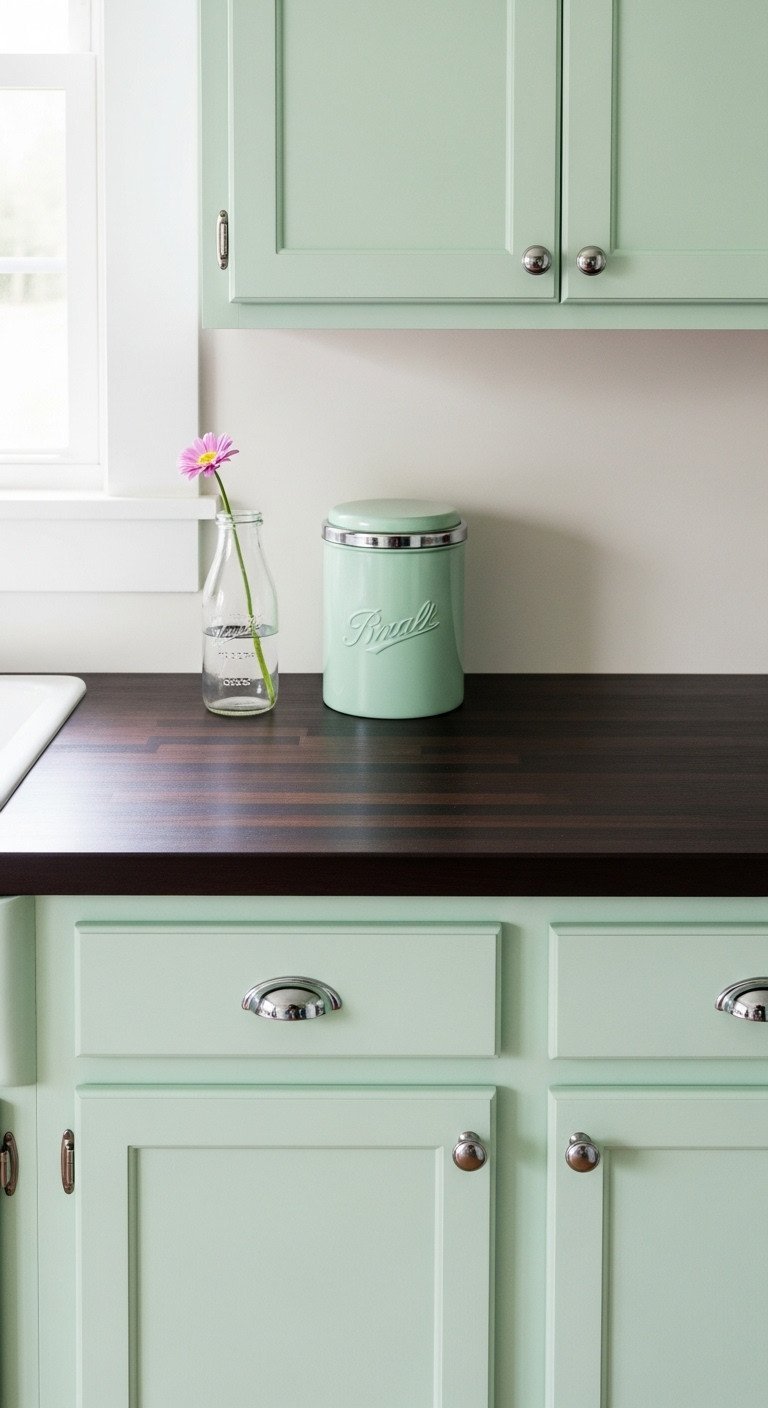
Save this sweet retro kitchen idea for a touch of nostalgia!
For a playful, retro-inspired look, pair a light and cheerful mint green with a deep, rich espresso brown. This high-contrast combination feels both nostalgic and fresh. The lightness of the mint keeps the space feeling bright, while the dark brown provides a sophisticated, grounding element.
Materials Needed:
- A soft, pastel mint green paint in a semi-gloss finish for a classic look
- Dark brown wood stain in an espresso or jacobean finish for a butcher block countertop
- Classic retro-style hardware, like polished chrome knobs and latch-style pulls
- A simple white subway tile backsplash
- Optional: Black and white vinyl tile for a classic checkered floor
Step-by-Step Directions:
- Go Pastel: Paint the cabinets in a cheerful mint green. This light color inherently keeps the kitchen feeling bright and open. A semi-gloss finish adds to the vintage, easy-to-clean feel.
- Create High Contrast: Stain a wood countertop or island top with a very dark espresso stain. This deep brown provides a dramatic and grounding contrast to the light green.
- Add Shine: Use polished chrome for all hardware and the faucet. The high shine is characteristic of the retro era and helps to bounce light around.
- Keep Other Elements Simple: With such a strong color story, keep the backsplash simple with classic white subway tile.
- Commit to the Theme (Optional): If you’re feeling bold, a black and white checkered floor will complete the vintage diner-inspired look perfectly.
Lesson Learned: The key to making this look feel chic and not kitschy is the quality of the finishes. Ensure the paint job on the cabinets is flawless and the dark stain on the wood is rich and even.
9. The Naturalist: Green Walls with Light Wood Cabinets
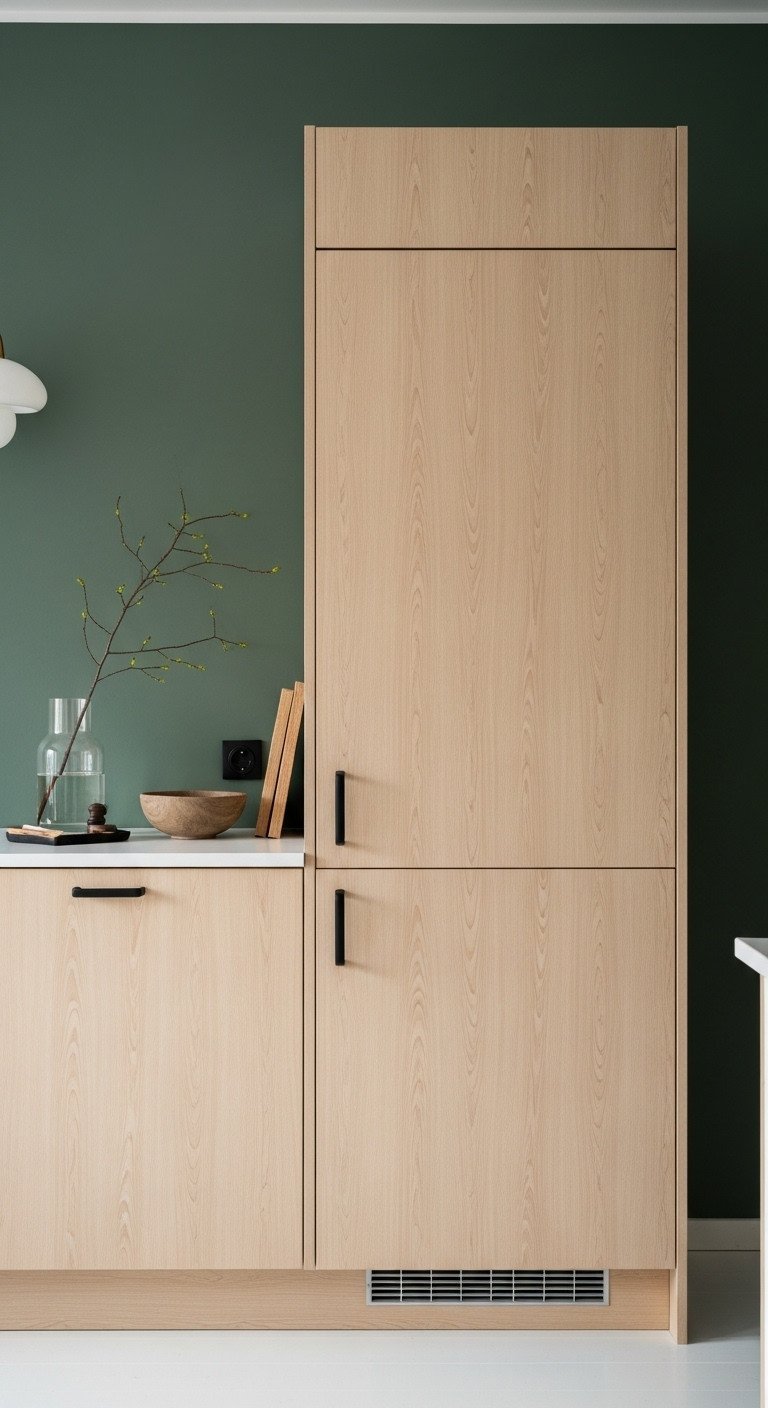
An easy way to add color! Pin this green wall kitchen idea.
Perhaps the lowest-commitment way to embrace the trend is by painting the walls green. This approach works beautifully with light brown wood cabinets, like birch, maple, or natural oak. The deep, muted green walls create a dramatic backdrop that makes the natural wood grain pop, resulting in a sophisticated, Scandinavian-inspired look.
Materials Needed:
- High-quality interior wall paint in a muted, earthy green (e.g., a desaturated moss or forest green) with a matte or eggshell finish
- Light, natural wood cabinets (birch, maple, or light oak are ideal)
- A crisp white or very light gray solid surface countertop
- Minimalist hardware, such as matte black or brushed nickel tab pulls
- Good quality painter’s tape for crisp lines
Step-by-Step Directions:
- Select Light Cabinets: This look is most effective when the “brown” element—the wood cabinets—is light and natural. This ensures the kitchen still feels bright, even with dark walls.
- Choose a Muted Green: Paint the walls in a rich but muted green. A matte finish will give it a soft, chalky appearance that feels sophisticated.
- Paint with Precision: Take the time to carefully tape off the cabinets, ceiling, and trim to get perfectly crisp paint lines. This is essential for a high-end look.
- Brighten with White: Use a solid white countertop. This will create a stark, clean line between the wood cabinets and the green walls, adding a necessary touch of brightness and modernity.
- Keep it Simple: The focus should be on the interplay between the wall color and the wood grain. Keep decor and hardware minimal and clean-lined.
Pro-Tip: Painting a dark color on the walls can highlight any imperfections. Take the time to properly prep your walls by filling any holes and sanding them smooth before you begin painting.
Key Takeaways: Your Quick Guide to a Bright Green & Brown Kitchen
- Balance is Everything: Never let dark green and dark brown dominate. Always introduce a third, light neutral—like creamy white walls, countertops, or a backsplash—to provide visual relief and reflect light.
- Layer Your Lighting: A beautiful color scheme can fall flat in a poorly lit room. Combine ambient (overhead), task (under-cabinet), and accent (pendants) lighting to eliminate shadows and create a warm glow.
- Let Surfaces Shine (A Little): Utilize surfaces that reflect light. A satin or semi-gloss finish on cabinets, a glossy backsplash tile, and polished metallic hardware all help bounce light around the room, making it feel brighter.
- Go Up, Not Out: To make a space feel taller and more open, use the darker color (green or brown) on the lower cabinets and a lighter color (light wood, white, or open shelving) for the uppers.
People Also Ask About Green and Brown Kitchens
What is the best countertop for green cabinets?
The best countertop for green cabinets is typically a light, neutral color like creamy white, soft gray, or beige quartz. This provides a bright contrast that prevents the kitchen from feeling too dark and allows the green cabinet color to be the star. For a warmer, more natural look, a light-colored butcher block also pairs beautifully.
Will a green and brown kitchen go out of style?
A green and brown kitchen is unlikely to go out of style quickly because it’s based on a timeless, nature-inspired palette. By choosing classic cabinet styles and muted, earthy shades of green and natural wood tones, the look remains sophisticated and grounded, avoiding the pitfalls of short-lived, overly bright color trends.
What color hardware goes with green cabinets and brown accents?
Warm metals like aged brass, champagne bronze, or copper are excellent choices for hardware in a green and brown kitchen. These finishes enhance the warmth of the wood and the richness of the green. For a more modern or industrial look, matte black provides a sharp, graphic contrast that works very well.
How do you brighten a dark green and brown kitchen?
To brighten a dark green and brown kitchen, focus on light-reflecting surfaces and strategic lighting. Use a light-colored backsplash and countertops, choose a satin paint finish over matte, add under-cabinet lighting to eliminate shadows on work surfaces, and ensure your overhead lighting is bright and plentiful.
Final Thoughts
A green and brown kitchen is more than just a color trend; it’s a way to bring the grounding, serene feeling of the outdoors into the heart of your home. By balancing rich colors with bright light and thoughtful details, you can create a space that is not only beautiful and sophisticated but also deeply warm and inviting. You don’t have to be afraid of color—you just have to use it with confidence.
Which of these ideas sparked the most inspiration for you? Let me know in the comments below
Last update on 2025-11-19 at 04:44 / Affiliate links / Images from Amazon Product Advertising API
